Alfa Romeo GT 2005 Owner handbook (in English)
Manufacturer: ALFA ROMEO, Model Year: 2005, Model line: GT, Model: Alfa Romeo GT 2005Pages: 307, PDF Size: 6.05 MB
Page 121 of 307
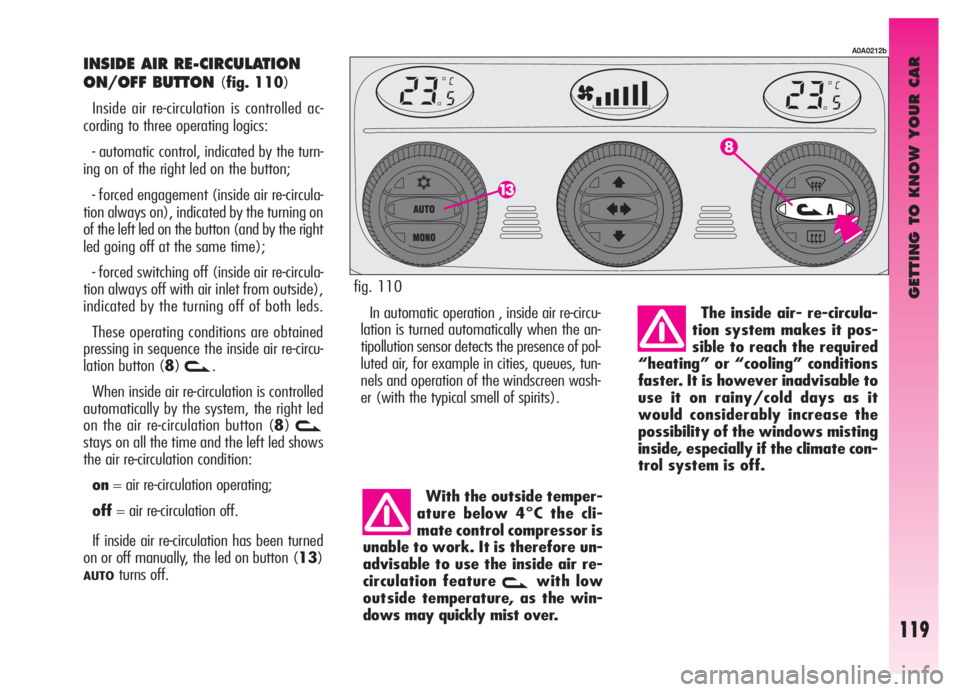
GETTING TO KNOW YOUR CAR
119
INSIDE AIR RE-CIRCULATION
ON/OFF BUTTON
(fig. 110)
Inside air re-circulation is controlled ac-
cording to three operating logics:
- automatic control, indicated by the turn-
ing on of the right led on the button;
- forced engagement (inside air re-circula-
tion always on), indicated by the turning on
of the left led on the button (and by the right
led going off at the same time);
- forced switching off (inside air re-circula-
tion always off with air inlet from outside),
indicated by the turning off of both leds.
These operating conditions are obtained
pressing in sequence the inside air re-circu-
lation button (8)
v.
When inside air re-circulation is controlled
automatically by the system, the right led
on the air re-circulation button (8)
v
stays on all the time and the left led shows
the air re-circulation condition:
on= air re-circulation operating;
off= air re-circulation off.
If inside air re-circulation has been turned
on or off manually, the led on button (13)
AUTOturns off.In automatic operation , inside air re-circu-
lation is turned automatically when the an-
tipollution sensor detects the presence of pol-
luted air, for example in cities, queues, tun-
nels and operation of the windscreen wash-
er (with the typical smell of spirits).The inside air- re-circula-
tion system makes it pos-
sible to reach the required
“heating” or “cooling” conditions
faster. It is however inadvisable to
use it on rainy/cold days as it
would considerably increase the
possibility of the windows misting
inside, especially if the climate con-
trol system is off.
A0A0212b
With the outside temper-
ature below 4°C the cli-
mate control compressor is
unable to work. It is therefore un-
advisable to use the inside air re-
circulation feature
vwith low
outsidetemperature, as the win-
dows may quickly mist over.
fig. 110
Page 122 of 307
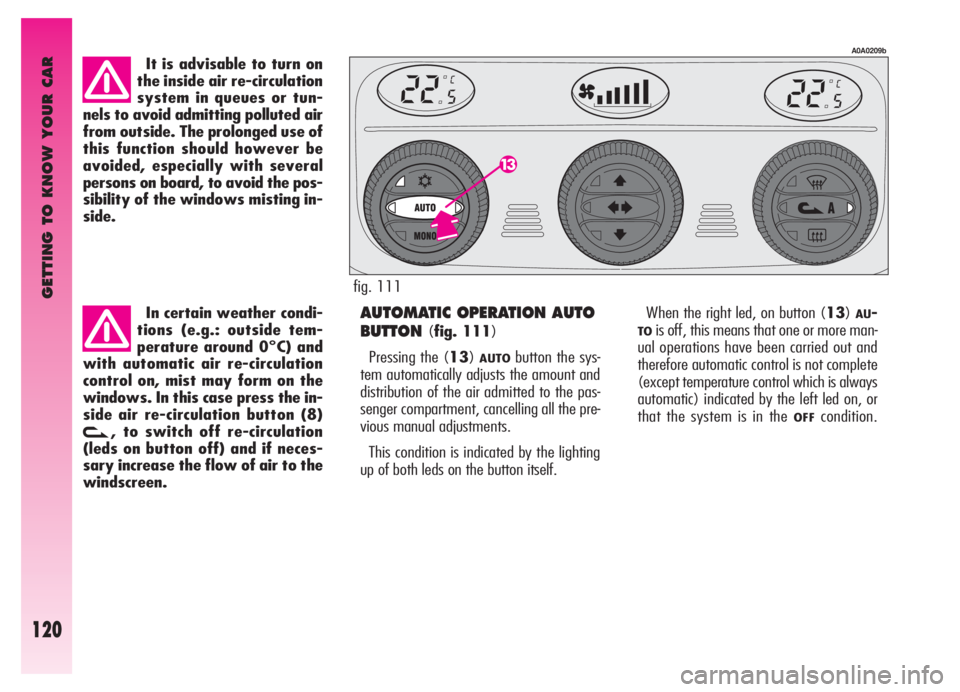
GETTING TO KNOW YOUR CAR
120
It is advisable to turn on
the inside air re-circulation
system in queues or tun-
nels to avoid admitting polluted air
from outside. The prolonged use of
this function should however be
avoided, especially with several
persons on board, to avoid the pos-
sibility of the windows misting in-
side.
AUTOMATIC OPERATION AUTO
BUTTON
(fig. 111)
Pressing the (13)
AUTObutton the sys-
tem automatically adjusts the amount and
distribution of the air admitted to the pas-
senger compartment, cancelling all the pre-
vious manual adjustments.
This condition is indicated by the lighting
up of both leds on the button itself.When the right led, on button (13)
AU-
TOis off, this means that one or more man-
ual operations have been carried out and
therefore automatic control is not complete
(except temperature control which is always
automatic) indicated by the left led on, or
that the system is in the
OFFcondition. In certain weather condi-
tions (e.g.: outside tem-
perature around 0°C) and
with automatic air re-circulation
control on, mist may form on the
windows. In this case press the in-
side air re-circulation button (8)
v, to switch off re-circulation
(leds on button off) and if neces-
sary increase the flow of air to the
windscreen.
A0A0209b
fig. 111
Page 123 of 307
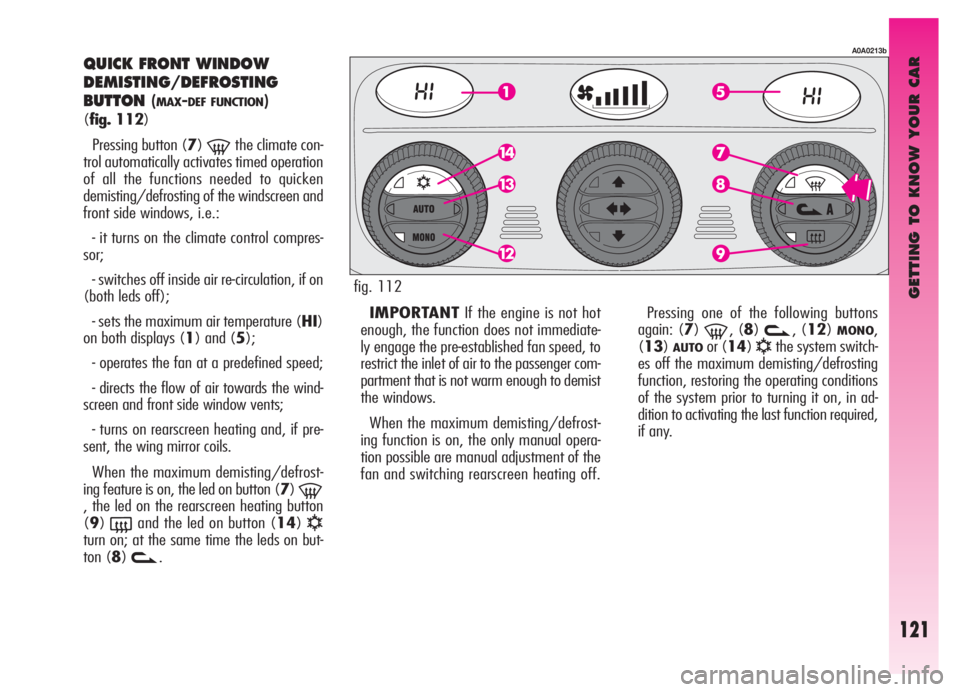
GETTING TO KNOW YOUR CAR
121
QUICK FRONT WINDOW
DEMISTING/DEFROSTING
BUTTON
(MAX-DEF FUNCTION)
(fig. 112)
Pressing button (7)
-the climate con-
trol automatically activates timed operation
of all the functions needed to quicken
demisting/defrosting of the windscreen and
front side windows, i.e.:
- it turns on the climate control compres-
sor;
- switches off inside air re-circulation, if on
(both leds off);
- sets the maximum air temperature (HI)
on both displays (1) and (5);
- operates the fan at a predefined speed;
- directs the flow of air towards the wind-
screen and front side window vents;
- turns on rearscreen heating and, if pre-
sent, the wing mirror coils.
When the maximum demisting/defrost-
ing feature is on, the led on button (7)
-, the led on the rearscreen heating button
(9)
(and the led on button (14)√turn on; at the same time the leds on but-
ton (8)
v.IMPORTANTIf the engine is not hot
enough, the function does not immediate-
ly engage the pre-established fan speed, to
restrict the inlet of air to the passenger com-
partment that is not warm enough to demist
the windows.
When the maximum demisting/defrost-
ing function is on, the only manual opera-
tion possible are manual adjustment of the
fan and switching rearscreen heating off.Pressing one of the following buttons
again: (7)
-, (8)v, (12)MONO,
(13)
AUTOor (14)√the system switch-
es off the maximum demisting/defrosting
function, restoring the operating conditions
of the system prior to turning it on, in ad-
dition to activating the last function required,
if any.
A0A0213b
fig. 112
Page 124 of 307
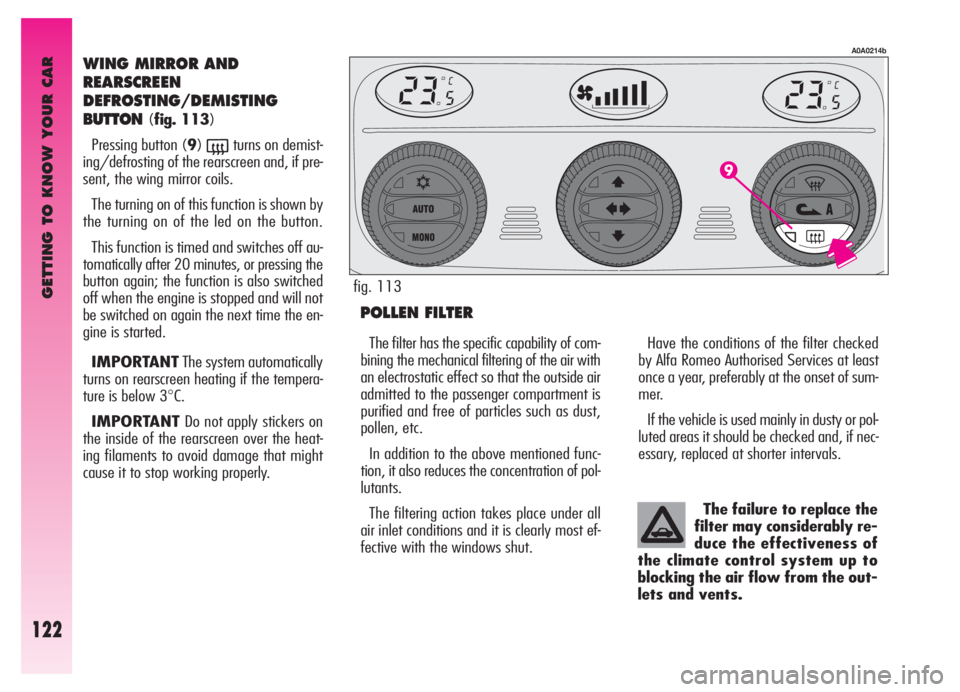
GETTING TO KNOW YOUR CAR
122
WING MIRROR AND
REARSCREEN
DEFROSTING/DEMISTING
BUTTON
(fig. 113)
Pressing button (9)
(turns on demist-
ing/defrosting of the rearscreen and, if pre-
sent, the wing mirror coils.
The turning on of this function is shown by
the turning on of the led on the button.
This function is timed and switches off au-
tomatically after 20 minutes, or pressing the
button again; the function is also switched
off when the engine is stopped and will not
be switched on again the next time the en-
gine is started.
IMPORTANTThe system automatically
turns on rearscreen heating if the tempera-
ture is below 3
°C.
IMPORTANTDo not apply stickers on
the inside of the rearscreen over the heat-
ing filaments to avoid damage that might
cause it to stop working properly.
POLLEN FILTER
Have the conditions of the filter checked
by Alfa Romeo Authorised Services at least
once a year, preferably at the onset of sum-
mer.
If the vehicle is used mainly in dusty or pol-
luted areas it should be checked and, if nec-
essary, replaced at shorter intervals.
A0A0214b
The filter has the specific capability of com-
bining the mechanical filtering of the air with
an electrostatic effect so that the outside air
admitted to the passenger compartment is
purified and free of particles such as dust,
pollen, etc.
In addition to the above mentioned func-
tion, it also reduces the concentration of pol-
lutants.
The filtering action takes place under all
air inlet conditions and it is clearly most ef-
fective with the windows shut.The failure to replace the
filter may considerably re-
duce the effectiveness of
the climate control system up to
blocking the air flow from the out-
lets and vents.
fig. 113
Page 125 of 307

Rear sensors are auto-
matically switched off
when the trailer’s electric
cable plug is inserted into the car
tow hitch socket.
Rear sensors are automatically switched
on by removing the trailer cable plug.
GETTING TO KNOW YOUR CAR
123
PARKING SENSORS
(fig. 113a)
(optional for versions/markets where
applicable)
The parking system detects and informs
the driver (through an intermittent acoustic
signal) about the presence of obstacles in
the rear part of the car.
ACTIVATION
The sensors are automatically activated
when the reverse gear is engaged.
The sound produced by the acoustic alarm
becomes continuous when the distance be-
tween the car and the obstacle is less that
30 cm.
ACOUSTIC SIGNAL
When the reverse gear is engaged an in-
termittent acoustic signal is automatically
activated.
The acoustic signal:
– raises with the reduction of distance be-
tween the car and the obstacle;
– becomes continuous when the distance
between the car and the obstacle is less that
30 cm and stops if the distance raises.
– is constant if the distance is unvaried.
If this situation takes place for side sensors,
the signal is stopped after about 3 seconds
to prevent sound indications when per-
forming manoeuvres near walls.
TOWING A TRAILER
fig. 113a
A0A0735b
Page 126 of 307
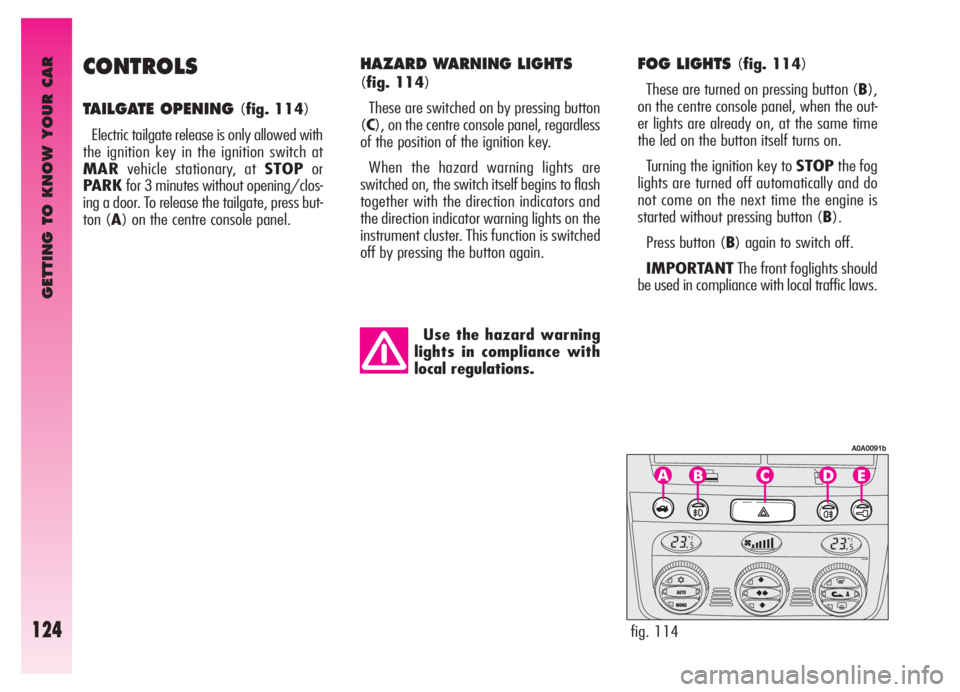
GETTING TO KNOW YOUR CAR
124
CONTROLS
TAILGATE OPENING (fig. 114)
Electric tailgate release is only allowed with
the ignition key in the ignition switch at
MARvehicle stationary, at STOPor
PARK for 3 minutes without opening/clos-
ing a door. To release the tailgate, press but-
ton (A) on the centre console panel.
Use the hazard warning
lights in compliance with
local regulations.
FOG LIGHTS (fig. 114)
These are turned on pressing button (B),
on the centre console panel, when the out-
er lights are already on, at the same time
the led on the button itself turns on.
Turning the ignition key to STOPthe fog
lights are turned off automatically and do
not come on the next time the engine is
started without pressing button (B).
Press button (B) again to switch off.
IMPORTANTThe front foglights should
be used in compliance with local traffic laws.
fig. 114
A0A0091b
HAZARD WARNING LIGHTS
(fig. 114)
These are switched on by pressing button
(C), on the centre console panel, regardless
of the position of the ignition key.
When the hazard warning lights are
switched on, the switch itself begins to flash
together with the direction indicators and
the direction indicator warning lights on the
instrument cluster. This function is switched
off by pressing the button again.
Page 127 of 307
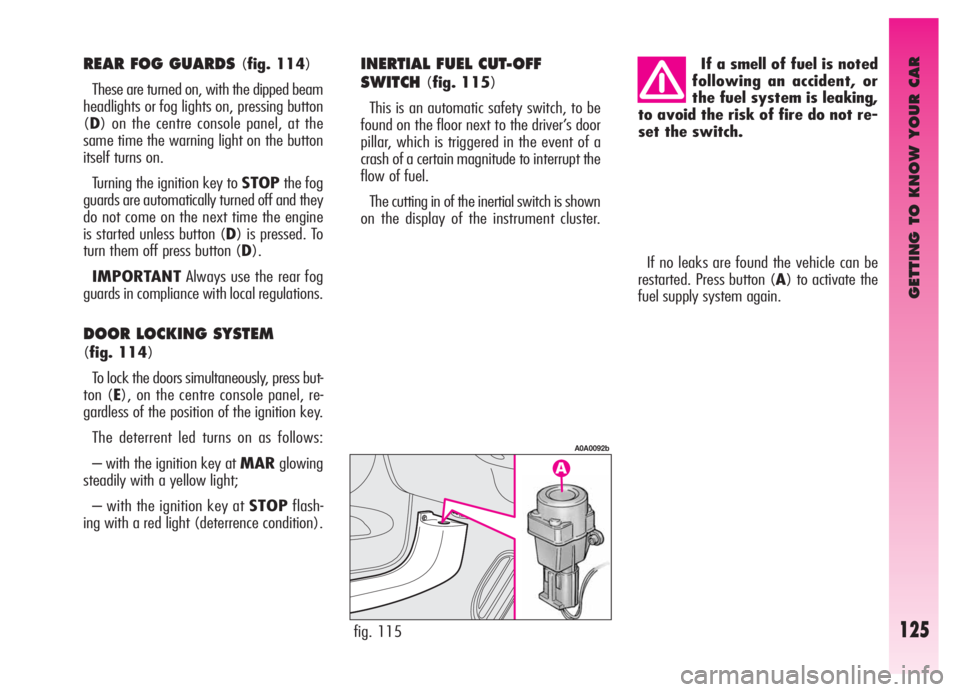
GETTING TO KNOW YOUR CAR
125
If no leaks are found the vehicle can be
restarted. Press button (A) to activate the
fuel supply system again.
fig. 115
A0A0092b
If a smell of fuel is noted
following an accident, or
the fuel system is leaking,
to avoid the risk of fire do not re-
set the switch.REAR FOG GUARDS (fig. 114)
These are turned on, with the dipped beam
headlights or fog lights on, pressing button
(D) on the centre console panel, at the
same time the warning light on the button
itself turns on.
Turning the ignition key to STOPthe fog
guards are automatically turned off and they
do not come on the next time the engine
is started unless button (D) is pressed. To
turn them off press button (D).
IMPORTANTAlways use the rear fog
guards in compliance with local regulations.
DOOR LOCKING SYSTEM
(fig. 114)
To lock the doors simultaneously, press but-
ton (E), on the centre console panel, re-
gardless of the position of the ignition key.
The deterrent led turns on as follows:
– with the ignition key at MARglowing
steadily with a yellow light;
– with the ignition key at STOPflash-
ing with a red light (deterrence condition).
INERTIAL FUEL CUT-OFF
SWITCH
(fig. 115)
This is an automatic safety switch, to be
found on the floor next to the driver’s door
pillar, which is triggered in the event of a
crash of a certain magnitude to interrupt the
flow of fuel.
The cutting in of the inertial switch is shown
on the display of the instrument cluster.
Page 128 of 307

GETTING TO KNOW YOUR CAR
126
The adjustment of Xenon headlights is au-
tomatic, therefore the versions fitted with
this optional lack the headlight aiming de-
vice (fig. 116a).
HAND BRAKE(fig. 117)
The hand brake lever is located between
the two front seats.
To operate the brake when the vehicle is
stationary, pull lever (A) upwards, until the
required braking action is obtained.
When the ignition key is at MAR, the
warning light on the instrument cluster
x
will come on.
fig. 117
A0A0620b
fig. 116a versions with Xenon headlights
A0A0677b
Adjust the beams every
time the load carried
changes.
For correct adjustment, bear in mind the
following conditions:
– position 0: one or two people occupy-
ing the the front seats
– position 1: five people;
– position 2: five people + load in the
boot;
– position 3: driver + maximum permis-
sible load all stowed in lug-
gage compartment
fig. 116 versions without Xenon headlights
A0A0093b
HEADLIGHT AIMING DEVICE
(fig. 116)
The headlights should be aimed correctly
depending on the vehicle load.
To do this, use the rocker button (A), on
the plate at the side of the steering column:
– press the arrow on the button (
A), to
increase by one position (e.g.:0
➟1➟2➟
3);
– press the arrow on the button (
S), to lower
by one position (e.g.:3
➟2➟1➟0);
The display (B) in the tachometer shows the
positions during adjustment.
Page 129 of 307

GETTING TO KNOW YOUR CAR
127
To release the hand brake:
– slightly lift the lever (A) and press the
release button (B);
– keeping the button pressed lower the
lever, the warning light
xon the instru-
ment cluster will go out.
To prevent the car from moving acciden-
tally, keep the brake pedal pressed when
engaging the hand brake.
IMPORTANTThe hand brake lever (A)
is fitted with a safety device which prevents
the brake from being released when, with
the lever pulled, button (B) is pressed.
Therefore, to release the brake, in addition
to pressing button (B), it is also necessary
to pull lever (A) further upwards to release
the safety device, then lower the lever com-
pletely.
IMPORTANTOn certain versions a
buzzer sounds to alert the driver if the car
is moved with the hand brake engaged.
GEARSHIFT LEVER (fig. 118)
The position of the single gears is shown
by the pictogram on the gearshift lever
knob.
When shifting gear, always fully depress
the clutch pedal. Before engaging reverse
gear (R) wait for the car to be stationary.
Certain versions are fitted with 6-gear gear-
box.
IMPORTANTReverse gear may only be
engaged with the car completely at a stand-
still. With the engine running, before en-
gaging reverse gear it is necessary to wait
for at least 3 seconds with the clutch pedal
fully depressed to prevent clashing and the
possibility of damaging the gears. The wheels should be
locked after a few clicks of
the hand brake. If it does
not occur contact Alfa Romeo Au-
thorised Services to have the hand
brake adjusted.To change gear smoothly,
the clutch pedal must be
fully depressed. Therefore,
there should be no obstacles on the
floor under the pedal unit: make
sure that any mats are well laid
and do not interfere with the ped-
als.
fig. 118
A0A0684b
Page 130 of 307
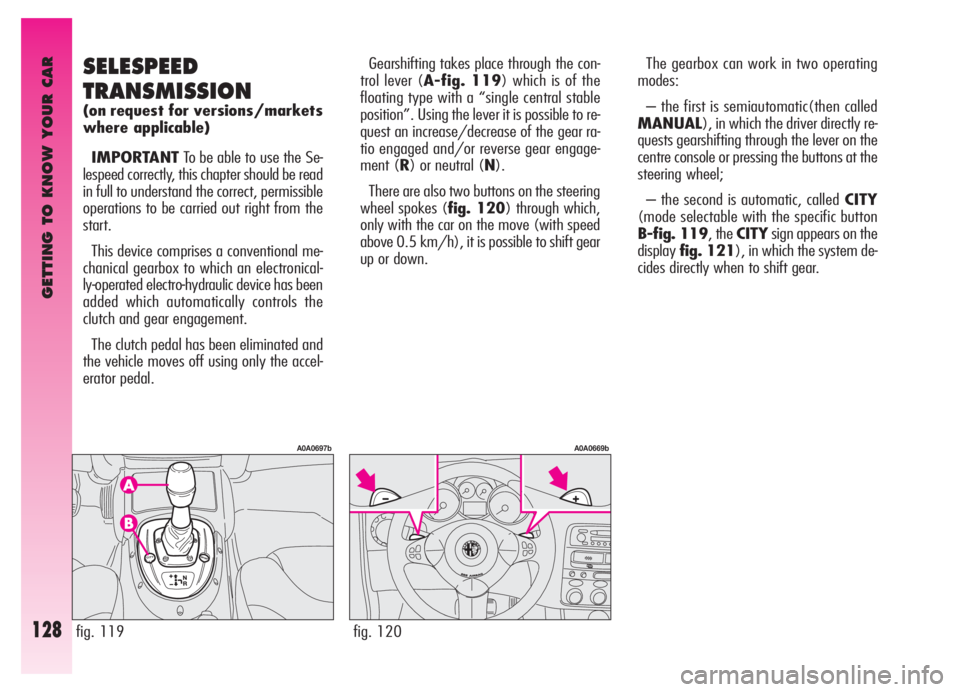
GETTING TO KNOW YOUR CAR
128
The gearbox can work in two operating
modes:
– the first is semiautomatic(then called
MANUAL), in which the driver directly re-
quests gearshifting through the lever on the
centre console or pressing the buttons at the
steering wheel;
– the second is automatic, calledCITY
(mode selectable with the specific button
B-fig. 119, the CITYsign appears on the
displayfig. 121), in which the system de-
cides directly when to shift gear.SELESPEED
TRANSMISSION
(on request for versions/markets
where applicable)
IMPORTANTTo be able to use the Se-
lespeed correctly, this chapter should be read
in full to understand the correct, permissible
operations to be carried out right from the
start.
This device comprises a conventional me-
chanical gearbox to which an electronical-
ly-operated electro-hydraulic device has been
added which automatically controls the
clutch and gear engagement.
The clutch pedal has been eliminated and
the vehicle moves off using only the accel-
erator pedal.Gearshifting takes place through the con-
trol lever (A-fig. 119) which is of the
floating type with a “single central stable
position”. Using the lever it is possible to re-
quest an increase/decrease of the gear ra-
tio engaged and/or reverse gear engage-
ment (R) or neutral (N).
There are also two buttons on the steering
wheel spokes (fig. 120) through which,
only with the car on the move (with speed
above 0.5 km/h), it is possible to shift gear
up or down.
fig. 119
A0A0697b
fig. 120
A0A0669b